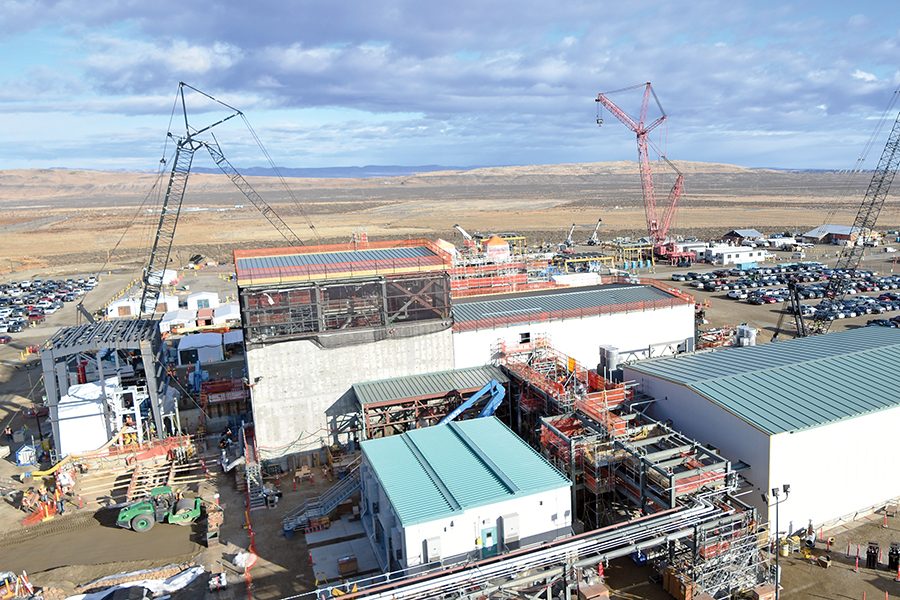
Home » Hanford drives Tri-City economy—but not as much as it once did
Hanford drives Tri-City economy—but not as much as it once did

April 15, 2020
Tri-City residents continue to reap the benefits from continued cleanup work at the Hanford site years after plutonium production ceased. Hanford spending supports about two jobs for every employee hired with federal dollars.
“The whole community benefits substantially, regardless of whether you’re a car dealership in Pasco, a restaurant in West Richland, or a real estate agent in south Kennewick,” said David Reeploeg, vice president for federal programs at the Tri-City Development Council (TRIDEC). “I think most industries in the Tri-Cities benefit from the fact that we do have the Hanford and (Pacific Northwest National Laboratory)-related, Department of Energy-related employment in the region.”
The current fiscal year funding allocates about $2.5 billion from the U.S. Department of Energy toward the Hanford site and about $1 billion for PNNL, operated by Battelle.
Combined, this amounts to about $1.5 billion in employee wages across nearly 150 companies for related employment, including all prime and subprime contractors.
“Every job that is funded by the federal spending at the Hanford reservation and the lab, supports around two jobs in the local community,” said Ajsa Suljic, regional labor economist for the Washington State Employment Security Department.
“This employment cluster related to DOE federal funding represents about 11.3 percent of total covered employment in the region and about 23.4 percent of total payroll/wages,” Suljic said.
It is the third largest employing cluster in the region, coming right after government (public administration, education and health care) and private health care services.
A decade ago the “Hanford cluster” represented 16.6 percent of total employment and 34 percent of wages.
For the total employment in the region, the average annual salary across Benton and Franklin counties is $51,619.
When analyzing work related only to federally-funded jobs, including PNNL and prime and subprime contractors, the average annual salary jumps to $106,000.
“The spending power of the average ‘Hanford cluster’ worker, including the lab, is two times of a total average worker for the area,” Suljic said. This can have a trickle-down effect, supporting local hospitality and tourism industries through an increase in expendable income.
“When compared to other (metropolitan statistical areas) our size in Washington, our prevailing wages are higher, and the reason why is the influence of different federal programs that pay at a higher rate,” said Karl Dye, president and chief executive officer for TRIDEC.
“The impact of those higher wages for federal contracts means the other people have to pay maybe a little bit higher wage than they would to compete for talent, so it increases the prevailing wage,” he said.
Reeploeg said that in 2018, the average annual wage for a Hanford-related job was between $75,000 to $95,000. The average wage in Washington was $61,896 in 2016, according to the state’s Office of Financial Management.
The Tri-Cities is better off for its Hanford influence, whether a person works directly at the site or not, partly due to those higher wages.
“We have people who live here who can afford to spend an evening at a local winery or bring family from out of town to go wine tasting,” Reeploeg said. “I wouldn’t be surprised if we still had large wine production (without Hanford nearby), but I don’t know if we would have as much wine tourism.”
The Hanford effect also is spread wider across the region than it once was, as more wage earners choose to live throughout the Tri-Cities instead of strictly near their job site.
“I think it’s pretty well understood that 40 years ago, the vast majority of the Hanford workforce lived and worked in Richland or West Richland, and now we’re seeing more and more of the Hanford workforce living in south Kennewick or west Pasco or other parts of the community. All you have to do is look at the bypass highway at 4:30 p.m.,” Reeploeg said.
As the home base for the workforce continues to diversify, so do the businesses that support the site. Economic experts say that while many businesses in the region started off doing work directly connected to the Hanford site, that has changed, and they are now less reliant on federal dollars to survive.
“There’s a couple of companies I’m familiar with that maybe started doing 90 or 100 percent of their work as DOE-funded and Hanford-related subcontracts. Now, they’ve been retaining that same level of work, but it only represents 10 or 20 percent of their total work portfolio,” Reeploeg said. “They’ve expanded and broadened their customer base in other areas so that if that DOE funding was to go away, they’re still a viable, local company.”
DOE dollars are still a critical piece of the economy, and TRIDEC plays a large part in demonstrating the need for continued robust funding, often helping secure more than is originally suggested by the White House administration during a budget cycle.
Reeploeg said Hanford has received $1.275 billion more in federal funding in the past decade than what was initially requested first by former President Barack Obama and then by President Donald Trump.
While the local economy still relies on this federal support, “I think the diversification of the economy and the growth of the overall population dilutes the impact of DOE funding from year to year,” Dye said.
This hasn’t happened by accident, say those responsible for monitoring the local economy.
“It’s been a very intentional effort over decades and decades and decades by TRIDEC and our ports and the cities and counties and the community as a whole to grow and diversify outside of being so dependent on federal money,” Reeploeg said.
“We’re not there yet. We’re still dependent upon it as an economy, but we’re continuing to be intentional and reduce that need every year.”
While the dependence remains, the site is no longer the exclusive economic driver it once was.
Those bygone times stay fresh in the minds of those who grew up in the Tri-Cities, including Reeploeg.
“I remember my third-grade class wrote letters to President Reagan asking him to keep the N Reactor operational. It was a community-wide effort because it was the lifeblood of the economy at the time.”
Those who support or seek services from local nonprofits also are aided by Hanford contractors, which give back to the community as part of their local mission.
Donations have reached the tens of millions for companies and employee-led fundraisers. The Hanford workforce often volunteers time or resources to charities such as the Tri-Cities Cancer Center Foundation, Children’s Developmental Center, United Way of Benton and Franklin Counties, Boys and Girls Clubs of Benton and Franklin Counties, Children’s Reading Foundation, Second Harvest, Union Gospel Mission, STEM Foundation, Junior Achievement, Toys for Tots, Meals on Wheels, Salvation Army, Relay for Life, YMCA of the Greater Tri-Cities, Friends of Badger Mountain, Washington State University Tri-Cities and Columbia Basin College.
Hanford
KEYWORDS april 2020




